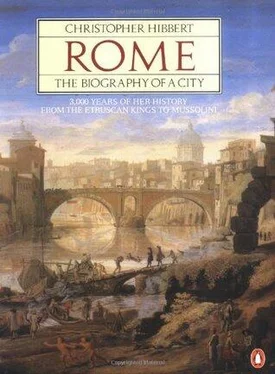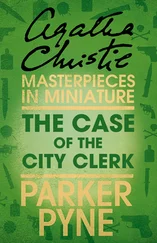Christopher Hibbert - Rome. The Biography of the City
Здесь есть возможность читать онлайн «Christopher Hibbert - Rome. The Biography of the City» весь текст электронной книги совершенно бесплатно (целиком полную версию без сокращений). В некоторых случаях можно слушать аудио, скачать через торрент в формате fb2 и присутствует краткое содержание. Жанр: Культурология, Искусство и Дизайн, на английском языке. Описание произведения, (предисловие) а так же отзывы посетителей доступны на портале библиотеки ЛибКат.
- Название:Rome. The Biography of the City
- Автор:
- Жанр:
- Год:неизвестен
- ISBN:нет данных
- Рейтинг книги:3 / 5. Голосов: 1
-
Избранное:Добавить в избранное
- Отзывы:
-
Ваша оценка:
- 60
- 1
- 2
- 3
- 4
- 5
Rome. The Biography of the City: краткое содержание, описание и аннотация
Предлагаем к чтению аннотацию, описание, краткое содержание или предисловие (зависит от того, что написал сам автор книги «Rome. The Biography of the City»). Если вы не нашли необходимую информацию о книге — напишите в комментариях, мы постараемся отыскать её.
Rome. The Biography of the City — читать онлайн бесплатно полную книгу (весь текст) целиком
Ниже представлен текст книги, разбитый по страницам. Система сохранения места последней прочитанной страницы, позволяет с удобством читать онлайн бесплатно книгу «Rome. The Biography of the City», без необходимости каждый раз заново искать на чём Вы остановились. Поставьте закладку, и сможете в любой момент перейти на страницу, на которой закончили чтение.
Интервал:
Закладка:
As the attention of the new emperor was diverted by the most trifling amusements [wrote Edward Gibbon in a characteristic passage], he wasted many months in his progress from Syria… and deferred till the ensuing summer his triumphal entry into the capital. A faithful picture, however, which preceded his arrival, and was placed by his immediate order over the altar of victory in the senate-house, conveyed to the Romans the just but unworthy resemblance of his person and manners. He was drawn in his sacerdotal robes of silk and gold… his head was covered with gems of an inestimable value. His eyebrows were tinged with black, and his cheeks painted with an artificial red and white. The grave Senators confessed with a sigh, that, after having long experienced the stern tyranny of their own countrymen, Rome was at length humbled beneath the effeminate luxury of Oriental despotism…
In a solemn procession through the streets of Rome the way was strewed with gold dust; the black stone, set in precious gems, was placed on a chariot drawn by six milk-white horses richly caparisoned. The pious emperor held the reins, and, supported by his ministers, moved slowly backwards, that he might perpetually enjoy the felicity of the divine presence. In a magnificent temple raised on the Palatine Mount, the sacrifices of the god Elagabalus were celebrated with every circumstance of cost and solemnity. The richest wines, the most extraordinary victims and the rarest aromatics were profusely consumed on his altar. Around the altar a chorus of Syrian damsels performed their lascivious dances to the sound of barbarian music, whilst the gravest personages of the state and army, clothed in long Phoenician tunics, officiated in the meanest functions with affected zeal and secret indignation.
To the temple of his deity, for his greater honour, Elagabalus transported all the most holy objects in Rome, including the Palladium, a small figure of Pallas Athene which had been brought from Troy by Aeneas. Shocked as they were by this blasphemous impiety, the Senators were even more horrified by the orgies which now took place in the imperial palace where the most exotic and extravagant meals were served at all hours of the day and night, where concubines and catamites disported themselves upon cushions stuffed with crocus petals and where the Emperor himself, dressed as a woman, made mockery of high Roman offices by bestowing them upon his various lovers and offended against the most sacred laws of Rome by violating a Vestal Virgin.
For fear lest his outrageous behaviour might result in her own ruin, his grandmother disowned him. Experiencing no difficulty in persuading the Praetorian Guard to assassinate both him and his mother, she had another grandson, Severus Alexander, declared emperor in his place. For thirteen years he and his mother ruled the Empire between them until in 235 both were killed in a mutiny of their troops.
Thereafter emperor followed emperor with bewildering frequency, there being six different rulers in Rome in the one year 238. Many were usurpers; most were army officers; nearly all died violent deaths, usually at the hands of soldiers supporting the claims of a rival. One of them, Philip the Arab, son of a desert chief, who reigned for five years from 244, celebrated the thousandth anniversary of the foundation of Rome with exceptionally savage wild beast hunts in the Colosseum, with shows and entertainments which ‘dazzled the eye of the multitude’, with mystic sacrifices and with music and dancing on the Campus Martius which was ‘illuminated with innumerable lamps and torches’. But such celebrations could not divert attention from the sad plight of Rome, the decline of the Senate much of whose authority was being assumed by the army, the slow disintegration of the Empire's frontiers and the recurrent financial crises within the city.
Little building of note had taken place in Rome since the time of Septimius Severus who restored the Portico d'Ottavia 20and the Temple of Vesta, who made the fine terrace known as the Belvedere on the Palatine 21and in whose honour were erected both the Arco degli Argentari 22near the Circus Maximus and the grand Arch of Septimius Severus in the Forum. 23Septimius Severus also began the huge and splendid baths which bear the name of his son Caracalla who inaugurated them in 217. They were the most luxurious in Rome, as the remains of them to be seen in the fountains of the Piazza Farnese, in the Salon d'Hercule of the Palazzo Farnese and in the baptistery of S. Giovanni in Laterano still testify. 24They were also the largest baths in the city, being able to accommodate 1,600 people at a time. Not until the reign of Diocletian were larger baths to be built. 25
Diocletian, a man of humble origins from Dalmatia, came to the throne in 284. Before his accession there had been a brief recovery in Rome's fortunes. Valerian, who had become emperor in 253 and his co-emperor and successor, his son Gallienus, had led strong forces against the Persians and Germans. Gallienus, after reorganizing the army, had inflicted a decisive defeat upon the Goths in what is now Yugoslavia in a battle that cost them no less than fifty thousand lives. And Aurelian, who succeeded Gallienus's successor, Claudius Gothicus, had been equally successful against Rome's enemies in northern Italy, and had built the defensive walls round the city which enclosed those parts of it that had spread far beyond the walls of the Republic. 26So, as the fourth century approached, the Empire, although still in financial chaos, was no longer on the verge of disintegration; and Diocletian, an administrator of exceptional ability, gave it the firm government it now needed. He enlarged the army; he overhauled the system of collecting taxes from the greatly increased number of Roman citizens who had become liable to pay them by the Constitutio Antoniniana of 212–13; and he increased the number of imperial provinces, removed their governors from military commands and, under his ultimate authority, created three other rulers whose capitals were established at Milan, Trier and in Salonica. His own capital was at Izmir on the Aegean coast, though the Senate remained in Rome, which was still the inspiration of the Empire, an ideal to be worshipped as a god.
Diocletian's reforms answered their purpose: the Empire was more orderly and united than it had been for generations. But the Emperor saw a threat to its unity and to the cult of the worship of Rome in that spreading, foreign, unpatriotic cult, Christianity. And he determined to stamp it out once and for all.
FOUR
CATACOMBS AND CHRISTIANS
One Sunday afternoon towards the middle of the fourth century a group of Roman schoolboys went out through a gate in the Aurelian Wall and walked along the Via Appia. ‘We went down into the catacombs,’ one of them, Eusebius Hieronymus, recorded. ‘These are caves excavated deep in the earth, and contain, on either hand as you enter, the bodies of the dead buried in the walls. It is all so dark there… Only occasionally is light let in to mitigate the horror of the gloom, and then not so much through a window as through a hole. You take each step with caution, as though surrounded by deep night.’
For generations these mazelike, subterranean galleries and passages, dug out of the soft tufa rock around Rome, had been used by a religious sect which, in Tacitus's words, ‘were detested for their abominations and popularly known by the name of Christians after one Christus who was put to death in the reign of Tiberius by the Procurator, Pontius Pilate’. The Christians had at first interred their dead in tombs above ground as well as below, but as land for burial became scarce and expensive and as persecution increased, they had taken to excavating cemeteries below ground where burials could take place without so much notice by the authorities or interference from hostile pagan crowds. The largest of them were dug on land belonging to such well-to-do converts as the Flavian relatives of the Emperor Domitian who gave permission to their fellow-Christians to use their villas for meetings and worship and their gardens as burial grounds. And so beneath the cypress trees along the Via Appia, and on other roads leading out of the city, warrens of dark tunnels were dug through the rock, some of them on four different levels like the Catacombs of St Calixtus, named after a former slave who, having served a sentence of hard labour in the Sardinian quarries, had been placed in charge of them before becoming leader of his sect. On the walls of the chambers were painted Christian symbols – the fish, the lamb, the shepherd – and scenes from the Bible, and in the recesses were placed not only the bodies of the dead, wrapped in lime-coated shrouds, but also precious objects such as lamps and vessels of golden glass, and relics of holy men, martyrs and saints. 1
Читать дальшеИнтервал:
Закладка:
Похожие книги на «Rome. The Biography of the City»
Представляем Вашему вниманию похожие книги на «Rome. The Biography of the City» списком для выбора. Мы отобрали схожую по названию и смыслу литературу в надежде предоставить читателям больше вариантов отыскать новые, интересные, ещё непрочитанные произведения.
Обсуждение, отзывы о книге «Rome. The Biography of the City» и просто собственные мнения читателей. Оставьте ваши комментарии, напишите, что Вы думаете о произведении, его смысле или главных героях. Укажите что конкретно понравилось, а что нет, и почему Вы так считаете.












